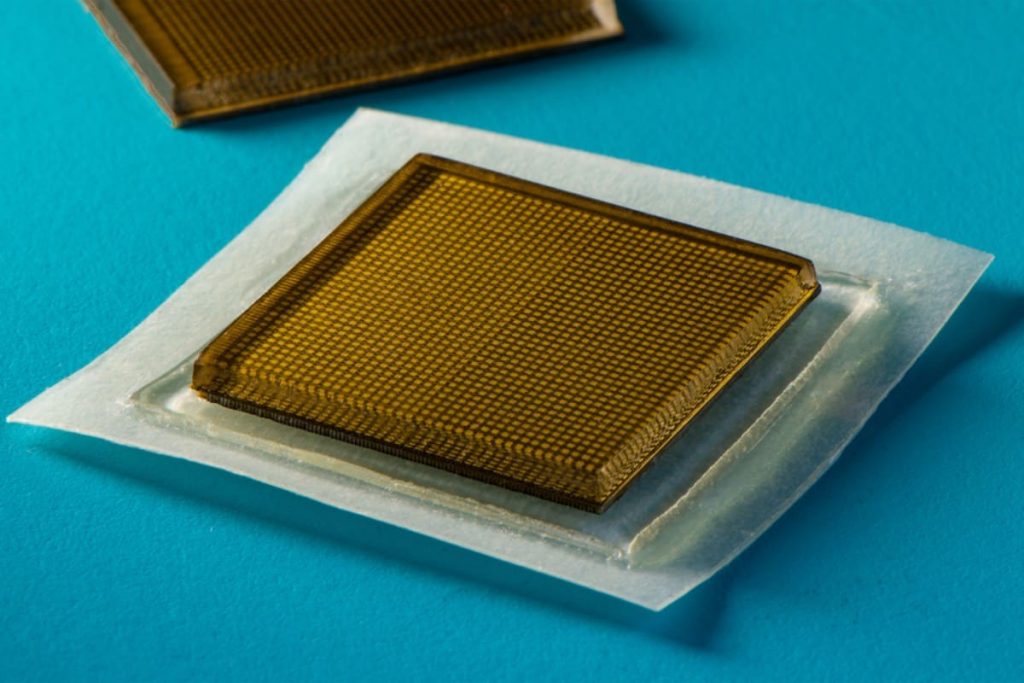MIT Engineers are developing ultrasound stickers that can see inside your body
July 29, 2022
MIT engineers have developed a sticker that creates ultrasound images of inside the body.
The stamp-sized device adheres to the skin and can provide continuous ultrasounds of internal organs for up to 48 hours.

The Ultrasound Sticker; made with a water-based hydrogel in order to be sticked on the skin suface. Credit: Felice Frankel
The stamp-sized device can provide continuous ultrasound images
Patches the size of a postage stamp stuck to your skin can provide continuous ultrasound imaging of internal organs for 48 hours. This can reveal details such as the human heart changing shape during exercise, or the stomach expanding and shrinking when a person eats or drinks.
“Welcome to the era of 'wearable imaging',” says study’s senior author, Xuanhe Zhao at the Massachusetts Institute of Technology.
In the current design, the stickers must be connected to instruments that translate the reflected sound waves into images. According to the researchers, the stickers could have immediate applications even in their current form. For example, the devices could be applied to patients in the hospital, similar to heart-monitoring EKG stickers, and could continuously image internal organs without requiring a technician to hold a probe in place for long periods of time.
Making the devices work wirelessly is a goal the team is currently working toward. If they are successful, the ultrasound stickers could be made into wearable imaging products that patients could take home from a doctor’s office or even buy at a pharmacy.
“We envision a few patches adhered to different locations on the body, and the patches would communicate with your cellphone, where AI algorithms would analyze the images on demand,” says Xuanhe Zhao, professor of mechanical engineering and civil and environmental engineering at MIT. “We believe we’ve opened a new era of wearable imaging: With a few patches on your body, you could see your internal organs.”
The study also includes lead authors Chonghe Wang and Xiaoyu Chen, and co-authors Liu Wang, Mitsutoshi Makihata, and Tao Zhao at MIT, along with Hsiao-Chuan Liu of the Mayo Clinic in Rochester, Minnesota.
How it works ?
Zhao and his colleagues solved that by combining a rigid transducer component that produces and detects ultrasound waves with a soft, sticky patch. The patch includes a layer of water-based hydrogel – for transmitting the ultrasound waves – sandwiched between two layers of flexible elastomer material to prevent the hydrogel dehydrating.
The team applied ultrasound stickers to the arm, neck, chest and waist of 15 volunteers who drank juice, lifted weights, jogged or biked in the lab. During these activities, ultrasound imaging from the stickers revealed changes in the size and shape of the lungs, diaphragm, heart, stomach and major arteries and veins.
There is still much work to be done before the ultrasound stickers can be used for medical monitoring anywhere. The stickers currently have to be connected by wires to a computer that translates the ultrasound waves into images and collects the data, which means it isn’t a fully portable system.
A team of engineers is working to make the stickers work wirelessly. They also develop AI-based software algorithms that can better interpret and diagnose sticker images. Then, Zhao suggests, patients and consumers will be able to package and buy ultrasound stickers and use them not only to monitor various internal organs, but also the progression of tumors, as well as the development of a fetus in the womb.
Still, “there are already point-of-care ultrasound devices with a data acquisition system at the size of a cell phone,” says Zhao. That gives him confidence that the computing component can be miniaturised and eventually integrated with the ultrasound sticker to become a truly wireless and fully portable imaging system.
The ultrasound stickers may provide a more flexible imaging option for hospitals to monitor patients without requiring human technicians to hold ultrasound probes, and they could be useful in situations where technicians are in short supply.
Demonstration video
The Massachusetts Institute of Technology released a video on YouTube in order to demonstrate the ultrasound patch. Here's the video :
Tell us what do you think about this article :